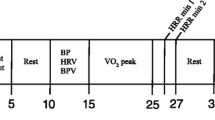Abstract
This study was designed to explore the effect of race and gender on the forehead muscle tension and finger temperature response to biofeedback-assisted relaxation training in individuals with normal blood pressure. Forty-five subjects—18 Black and 27 White, 25 males and 20 females—participated in eight sessions of autogenic relaxation training and thermal biofeedback. Multivariate analysis of variance of the variables measured at baseline (systolic BP, diastolic BP, sodium excretion, anxiety) was significant for gender. Univariate analysis showed males different from females in DBP, Na+ excretion, and trait anxiety. Pretest values of muscle tension were similar by gender, but pretest temperatures were lower in males than females. Repeated measures ANOVA for muscle tension showed a significant effect of period. For temperature, a significant effect of period, gender, and gender × period was observed. Males increased temperature more than females. There was no effect of history of hypertension on the relaxation response. Multiple regression performed on change in muscle tension and change in temperature showed that pretest muscle tension predicted change in muscle tension. Four variables contributed to the variance in change in temperature: pretest temperature, sodium excretion, and state and trait anxiety.
Similar content being viewed by others
References
Anderson, N. B., Lane, J. D., Maranka, M., & Williams, R. B., Jr. (1988). Racial differences in blood pressure and forearm vascular responses to the cold face stimulus.Psychosomatic Medicine, 50, 57–63.
Anderson, N. B., Lane, J. D., Taguchi, F., Williams, R. B., & Houseworth, S. J. (1989). Race, parental history of hypertension, and patterns of cardiovascular reactivity in women.Psychophysiology, 26, 35–47.
Baum, A., & Grunberg, N. E. (1991). Gender, stress and health.Health Psychology, 10, 80–85.
Blanchard, E. B., Morrill, B., Wittrock, D. A., Scharff, L., & Jaccard, J. (1989). Hand temperature norms for headache, hypertension, and irritable bowel syndrome.Biofeedback and Self-Regulation, 14, 319–331.
Cohen, R. A., & Coffran, J. P. (1981). Beta adrenergic vasodilation mechanisms in the finger.Circulation Research, 49, 1196–1201.
Dimsdale, J., Graham, R., Ziegler, M., Zusran, R., & Berry, C. (1987). Age, race, diagnosis and sodium effects on the pressor response to infused norepinephrine.Hypertension, 10, 564–569.
Freedman, R., Sabharwal, S., Ianni, P., Desai, N., Wenig, P., & Mayes, M. (1988). Non-neural β-adrenergic vasodilating mechanism in temperature biofeedback.Psychosomatic Medicine, 50, 394–401.
Freedman, R. R., Sabharwal, S. C., & Desai, N. (1987) Sex differences in peripheral vascular adrenergic receptors.Circulation Research, 61, 581–585.
Ganong, W. F. (1995).Review of Medical Physiology (15th edition). Los Altos, CA: Lange Medical Publications.
Green, E. E., Green, A. M., & Norris, P. A. (1980). Self-regulation training for control of hypertension.Primary Cardiology, 6, 126–137.
Joint National Committee on Detection, Evaluation, and Treatment of High Blood Pressure (1993).Archives of Internal Medicine, 153, 154–183.
Lewis, D., Ray, W. J., Wilkinson, M. O., & Ricketts, R. (1984). Self report and heart rate responses to a stressful task.International Journal of Psychophysiology, 2, 33–37.
Light, K. C., Koepke, J. P., Obrist, P. A., & Willis, P. W. (1983). Psychological stress induces sodium and fluid retention in men at high risk for hypertension.Science, 22, 429–431.
Light, K. C., Obrist, P. A., Sherwood, A., Vance, S. A., & Strogatz, D. S. (1987). Effects of race and marginally elevated blood pressure on cardiovascular responses to stress in young men.Hypertension, 19, 555–563.
Light, K. C., Turner, J. R., Hinderliter, A. L., & Sherwood, A. (1993). Race and gender comparisons: I. Hemodynamic responses to a series of stressors.Health Psychology, 22, 354–365.
McAdoo, W. G., Weinberger, M. H., Miller, J. Z., Fineberg, N. S., & Grim, C. E. (1990). Race and gender influence hemodynamic responses to psychological and physical stimuli.Journal of Hypertension, 8, 961–967.
McGrady, A., & Roberts, G. (1992). Racial differences in the relaxation response of hypertensives.Psychosomatic Medicine, 54, 71–78.
Novy, D. M., & Nelson, D. V. (1993). Psychometric comparability of the State Trait Anxiety Inventory for different ethnic subpopulations.Psychological Assessment, 5, 343–349.
Rosch, P. J. (1994). Does stress cause hypertension?Stress Medicine, 10, 141–143.
Spielberger, C. D. (1972).Anxiety: Current trends in theory and research. New York: Academic.
Spielberger, C. D., Gorsuch, R. L., & Lushene, R. E. (1970).STAI manual for the state-trait anxiety inventory. Palo Alto, CA: Consulting Psychologists Press.
Trieber, F. A., Musante, L., Braden, O., Areneman, F., Strong, W. B., Levy, M., & Leverett, S. (1990). Racial differences in hemodynamic responses to the cold stimulus in children and adults.Psychosomatic Medicine, 52, 286–296.
Weaver, M., & McGrady, A. (1995). Blood pressure response to biofeedback-assisted relaxation: Can it be predicted?Biofeedback and Self-Regulation, 20, 229–240.
Author information
Authors and Affiliations
Additional information
We thank Barbara Coen for assistance with the group relaxation sessions. We thank Robert C. Spain, Jr., M.Ed., LPCC for his assistance with the initial preparation of the manuscript. We particularly thank Sadik Khuder, Ph.D., biostatistician, Department of Medicine, for reanalysis and reinterpretation of the data. A preliminary report of this research was presented as a citation poster at the Association for Applied Psychology and Biofeedback in Dallas, 1991.
Rights and permissions
About this article
Cite this article
Roberts, G., McGrady, A. Racial and gender effects on the relaxation response: Implications for the development of hypertension. Biofeedback and Self-Regulation 21, 51–62 (1996). https://doi.org/10.1007/BF02214149
Issue Date:
DOI: https://doi.org/10.1007/BF02214149




